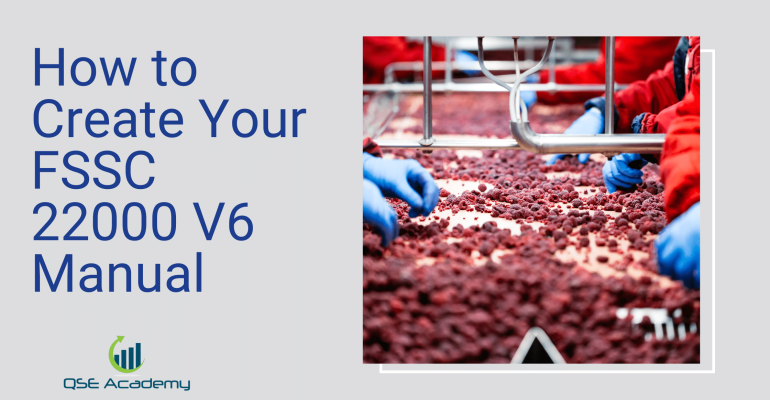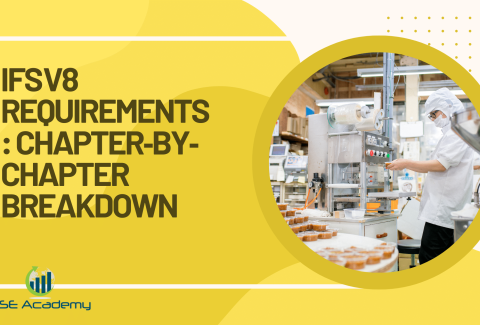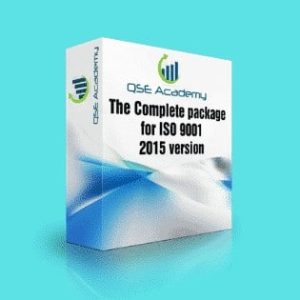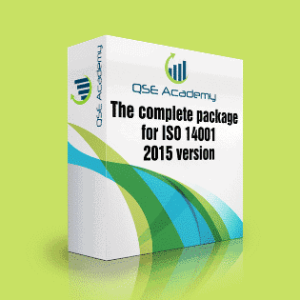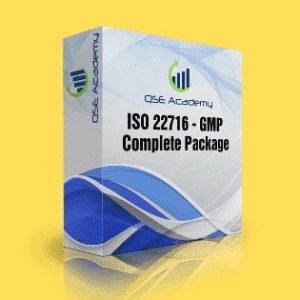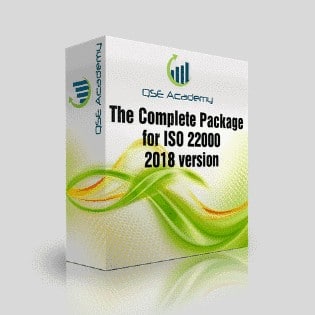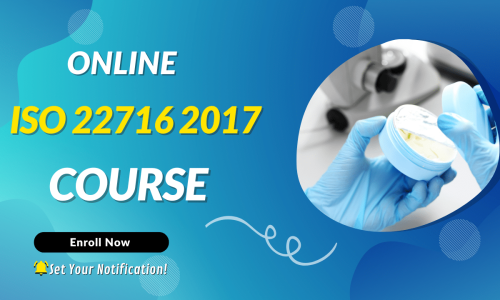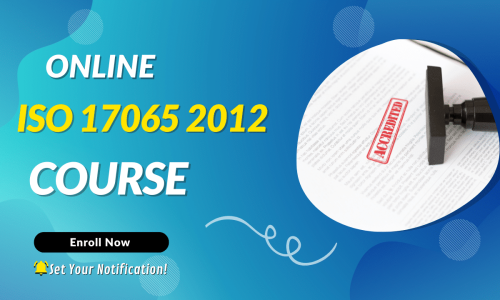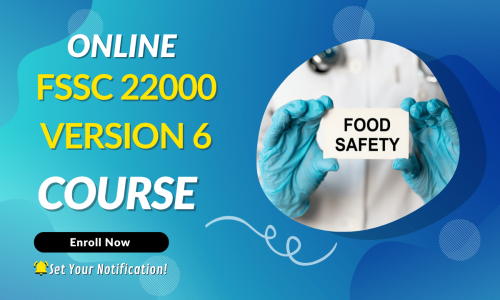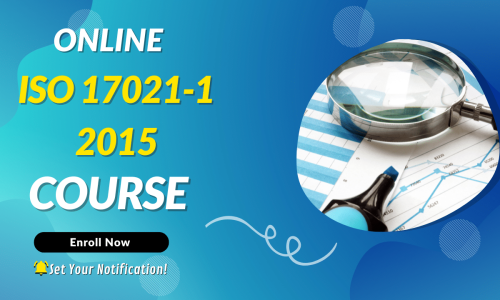How to Create Your FSSC 22000 V6 Manual
Last Updated on October 13, 2025 by Hafsa J.
How to Create Your FSSC 22000 V6 Manual
Let’s be honest—writing your FSSC 22000 manual can feel like staring at a blank page with a hundred questions in your head. Where do you even start? What’s required? Do you really need to include everything? I’ve seen food safety teams spin their wheels for weeks trying to “get it right,” only to end up with a bulky, overcomplicated document that no one actually uses.
In my experience helping companies build audit-ready food safety systems, the best manuals aren’t the longest—they’re the clearest. Your manual should help you tell the story of your system. It should show how your processes work together, how your team controls food safety, and how your operation meets the requirements of FSSC 22000 Version 6.
This guide is here to walk you through exactly how to do that—step by step. I’ll show you what to include, how to structure it, and what auditors actually care about when they open your manual. No fluff. No guesswork. Just real guidance that works in the field.
Let’s make this simple—and maybe even a little satisfying. Ready to build a manual that actually helps your team, not just your auditor? Let’s dive in.
Understand the Role of the Manual in FSSC 22000 V6
Before we jump into building your manual, let’s get clear on why it matters. I’ve had clients ask, “Wait—doesn’t ISO 22000:2018 say a manual isn’t required?” And technically, yes. But when it comes to FSSC 22000, the manual is still a key expectation—especially during audits.
Think of it like this: your manual is the front door to your food safety system. It’s the first thing an auditor will look at to get the full picture of how your operation works. If your manual is messy, vague, or incomplete, that first impression won’t be great.
Here’s what the manual does for you:
-
It lays out your food safety scope—what your system covers, and what it doesn’t.
-
It gives an overview of your organization’s context, key risks, and responsibilities.
-
It connects the dots between your policies, procedures, and records.
-
And most importantly, it shows that your FSMS is designed, documented, and actually used.
A solid manual gives you a strong foundation. It helps align your team, guide your audits, and keep everything consistent when your business grows or changes. I’ve seen companies get flagged not because their operations were bad—but because their manual didn’t reflect the great work they were actually doing.
So, now that we know why it matters, let’s walk through what you really need to include—and how to build a manual that works for you, not just your certification body.
How to Structure Your Manual Step by Step
So you know what to include—now let’s talk about how to actually lay it all out. Because a well-structured manual doesn’t just meet the requirements—it makes life easier for everyone who uses it. That includes your team, your auditor, and yes, future-you when it’s time to review or update it.
Here’s the layout I recommend (and use with clients all the time):
-
Section 1: Introduction
A brief overview of the manual, its purpose, and how it fits into your food safety system. This is also a good place to explain document control—who owns the manual, how it’s approved, and when it’s reviewed. -
Section 2: Scope and Context
Include your FSMS scope statement, any exclusions, and a short summary of internal and external factors that influence your system. Mention your key stakeholders and compliance obligations here too. -
Section 3: Food Safety Policy and Objectives
Drop in your official food safety policy and current objectives. Make sure they’re aligned with your processes—and easy for staff to understand. -
Section 4: Process Interaction Map
A visual diagram that shows how your core processes connect—from raw material intake to final product release. Keep it simple but accurate. Bonus points if you link this to key control points like CCPs and OPRPs. -
Section 5: Procedure and Record Summary
A table or index listing all your supporting procedures and records. Include:-
Procedure title
-
Document number
-
Related clause (ISO 22000 / PRP / FSSC requirement)
-
Owner or department
-
Last review date
-
A few structure tips that go a long way:
-
Match the clause numbering from ISO 22000:2018
It helps auditors track how your system complies with the standard—and it keeps your manual aligned if you update your system later. -
Don’t stuff it with full procedures
The manual is an overview. Just reference procedures, don’t copy and paste them in. Keep it lean. -
Use headers, bullet points, and white space
Make it readable. Think of your future auditor or new QA hire—they should be able to find what they need in seconds.
Real-world insight:
I once worked with a packaging plant that turned their 85-page manual into a clean 22-page version with smart referencing and a clause-linked matrix. Not only did the audit go smoother, but training new team members became ten times easier.
How to Integrate the FSSC 22000 V6 Additional Requirements
Here’s the part that trips up even experienced food safety teams: the extra requirements that FSSC 22000 adds on top of ISO 22000 and the PRPs. These aren’t optional. They’re a formal part of the certification scheme, and your manual needs to show where and how you address each one.
But here’s the good news: you don’t need to cram them all into one giant section. You just need to make it easy for an auditor—or your internal team—to see how these extra elements are being managed within your system.
The key Version 6 requirements you need to reference:
-
Food Defense Plan – Show that you’ve identified potential threats and have security measures in place.
-
Food Fraud Mitigation Plan – Describe how you assess and reduce the risk of fraudulent ingredients or materials.
-
Allergen Management – Reference your allergen control procedures, especially if you handle multiple product lines or shared equipment.
-
Product Labelling and Claims – Point to procedures that verify label accuracy, especially around allergens, nutritional info, and legal claims.
-
Environmental Monitoring – If you produce high-risk or RTE products, note how your EMP is documented and reviewed.
-
Equipment Management – Explain how equipment is maintained, cleaned, and monitored—especially anything that could affect food safety.
-
Training Requirements – Link to your training procedures and records for food safety-related roles, showing competency and awareness.
How to include them in your manual:
-
Option 1: Add a dedicated section
You can include a standalone section (e.g., “Section 6: FSSC 22000 Additional Requirements”) with a summary of how each item is handled and where supporting documents live. -
Option 2: Use a cross-reference matrix
My personal favorite. Create a simple table that lists each requirement, the clause it falls under, and the related document or procedure. It’s a fast, easy way to show full compliance.
What works in the real world:
One client I worked with—a ready-to-eat meal producer—added a one-page annex that mapped each FSSC V6 requirement to the corresponding SOP or form in their system. When the auditor asked, “Where’s your food fraud mitigation plan?”—they flipped to that page and had it ready in seconds. No scrambling. No guessing.
Bottom line:
FSSC 22000 wants to see that these critical topics are not just mentioned, but fully integrated into your system. Your manual doesn’t need to explain every detail—but it does need to show how each requirement is addressed, where it’s documented, and who’s responsible.
How to Keep Your Manual Clear, Practical, and Auditor-Friendly
Let’s be honest—if your FSSC 22000 manual is overly complicated, filled with jargon, or bloated with unnecessary detail, no one’s going to use it. Not your team. Not your auditor. And definitely not you when you’re in the middle of an audit.
The best manuals I’ve seen aren’t the longest—they’re the most usable. So let’s look at how to keep yours functional, current, and clean.
Focus on clarity, not word count
Avoid long-winded explanations. Your goal isn’t to impress with how much you know—it’s to make your system understandable and easy to follow.
-
Use plain language and avoid technical buzzwords unless you absolutely have to.
-
Format for scanability: short paragraphs, bullet points, and clear section headings.
-
Keep each section focused—don’t bury procedures inside long blocks of text.
Keep it top-level—reference, don’t repeat
I’ve seen manuals that try to include entire SOPs word-for-word. That makes version control a nightmare. Instead:
-
Reference procedures and forms, don’t rewrite them.
-
Use a document control section with links (or file paths) to the latest versions.
-
That way, when you update a procedure, you don’t need to touch the manual.
Build in document control
Even the best-written manual becomes useless if it’s outdated. Auditors will check version numbers, revision dates, and approval signatures—so stay ahead of them.
Here’s what to include:
-
A revision log with version history and change summaries
-
A document approval page with roles and sign-offs
-
A review schedule—typically annual or whenever major changes occur
Insider tip from the field:
One bakery I worked with set up a quarterly FSMS review calendar. Every three months, one part of the system—including the manual—was reviewed for accuracy and relevance. No scrambling before audits. No surprises. Just steady, proactive control.
Quick checklist to test your manual’s usability:
-
Can a new employee understand your food safety system by reading it?
-
Can your team find the correct version without digging?
-
Can your auditor trace how your FSMS meets each clause of the standard?
If you answered yes to all three, you’re in great shape.
Pro Tips and Insider Insights That Save Time (and Headaches)
After helping dozens of companies write, revise, and streamline their FSSC 22000 manuals, I’ve picked up a few practical tricks that can seriously cut down your effort—and boost your audit readiness.
These are the same tips I share with clients to make their manuals more useful, more readable, and more respected by auditors.
Pro Tip: Mirror the ISO 22000 Clause Structure
Use the same numbering system from ISO 22000:2018 in your manual. It instantly shows alignment, and auditors can trace requirements easily without flipping back and forth between documents.
Why it works: It saves time during audits and proves your system was built intentionally—not just pieced together.
Insight: Use a Manual Index With Live Document Links
If you’re managing your system digitally (and you should be), add hyperlinks in your manual that lead directly to the most current versions of procedures, forms, or diagrams.
Why it helps: Auditors can follow your system in real time, and your team isn’t stuck digging through folders to answer basic questions.
Pro Tip: Keep Each Section Short and Purposeful
Your manual isn’t a textbook. Each section should explain what is being done—not every step of how to do it. Save that detail for your SOPs.
What I’ve seen: Manuals over 40 pages often get ignored. Manuals under 20 pages with smart references? Actually used.
Insight: Assign Ownership Early
From day one, decide who owns the manual—who updates it, reviews it, and keeps version control on track. Otherwise, it falls through the cracks fast.
Bonus tip: Include a responsibility table right inside the manual. It sets expectations and helps build accountability.
Pro Tip: Build It with the Audit in Mind
When writing your manual, imagine sitting across from an auditor. If they asked, “How do you manage allergen controls?”—could you point to the answer in the manual or the procedures it references?
This mindset shift changes everything. You stop writing for theory and start writing for real-world clarity.
Common Mistakes to Avoid and FAQs from the Field
Even the most dedicated food safety teams make mistakes when building their FSSC 22000 manual. And to be fair, it’s easy to do—especially if you’re pulling from old templates or starting from scratch. The good news? These missteps are totally avoidable once you know what to look for.
Mistake 1: Turning the Manual Into a Catch-All
I’ve seen manuals packed with full SOPs, flowcharts, and every form ever created. The result? A bulky, unreadable document that no one updates.
What to do instead: Keep your manual top-level. Reference your SOPs, don’t paste them in. Your manual should guide, not overwhelm.
Mistake 2: Leaving Out Scope or Exclusions
Your scope statement is one of the first things auditors look for. If it’s unclear—or missing altogether—it can raise concerns about the boundaries of your FSMS.
Fix: Be specific about what your system covers and justify any exclusions. Even if something seems obvious to you, it needs to be clearly documented.
Mistake 3: Writing It and Forgetting It
Creating the manual isn’t a one-time task. If your last revision was dated three years ago, it signals a lack of system control.
Fix: Set a regular review schedule and stick to it. Link your review process to management review or internal audit activities so it doesn’t get forgotten.
Mistake 4: Using a Generic Template Without Customizing It
Templates are great for structure—but not if they sound nothing like how your business actually runs. Auditors can spot copy-paste jobs a mile away.
Fix: Make it yours. Use your language, your process names, and your flow diagrams. Keep it real.
Frequently Asked Questions
Q: Do I really need a manual if ISO 22000 doesn’t require one?
A: Yes—for FSSC 22000 certification, a manual is expected. It helps tie your system together, shows structure, and simplifies your audit.
Q: Can I just download a template and be done?
A: A template is a helpful start—but only if you adapt it. If it doesn’t reflect how your actual system operates, it can create more problems than it solves.
Q: How long should the manual be?
A: There’s no rule—but shorter is better. If you can explain your system clearly in 15 to 25 pages with good references, that’s ideal.
Build a Manual That Works for You—Not Just the Auditor
Let’s bring it full circle. Creating your FSSC 22000 Version 6 manual doesn’t have to be confusing, overwhelming, or stuffed with paperwork no one will ever read. Done right, your manual becomes a powerful tool—not just for audits, but for training, alignment, and long-term food safety control.
We’ve covered:
-
What the manual really is—and why it still matters
-
Exactly what to include to meet FSSC 22000 V6 expectations
-
How to structure it for clarity, traceability, and usability
-
Practical tips to make it easier to manage (and easier to audit)
-
The common mistakes to avoid—and how to fix them
-
Straight answers to the questions I hear most from clients in your shoes
And through it all, here’s the one thing I hope sticks with you: your manual should reflect your real system—not a theoretical one. It should be clear enough for a new team member to follow and strong enough for an auditor to respect.
With years of experience helping companies across food production, packaging, and distribution, I’ve seen how the right approach to documentation can transform not just audits—but the way your team works.
Need help getting started or improving your current manual?
Download our free FSSC 22000 V6 Manual Template to save time, avoid guesswork, and stay on track. Or, reach out to QSE Academy for expert guidance and done-for-you documentation support tailored to your operation.
Your system deserves a manual that actually works. Let’s build it.
Whether it’s ISO 9001, ISO 22000, or the cosmetics-focused ISO 22716, I’ve spent my career I’m not here to call myself an expert—I prefer “enthusiast” because I truly love what I do. When I’m not writing about standards, you’ll probably find me playing Piano 🎹, connecting with people, or diving into my next big project💫. I’m an engineer specialized in the food and agricultural industry
make ISO standards less intimidating and more approachable for everyone.
turning complex jargon into clear, actionable steps that businesses can actually use.
There’s something incredibly rewarding about helping people navigate food safety and quality management systems
in a way that feels simple, practical, and even enjoyable.
I have a Master’s in QHSE management and over 12 years of experience as a Quality Manager
I’ve helped more than 15 companies implement ISO 9001, ISO 22000, ISO 22716, GMP, and other standards
My clients include food producers, cosmetics manufacturers, laboratories, and service companies
I believe quality systems should be simple, useful, and efficient.

